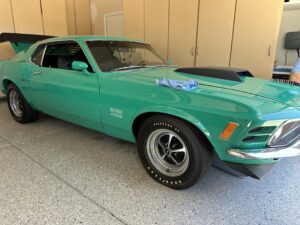
This 1970 Ford Boss 429 VIN Verification was done by our team member in Rancho Cucamonga, Ca. on 8-18-2025

This 1970 Ford Boss 429 VIN Verification was done by our team member in Rancho Cucamonga, Ca. on 8-18-2025
The 1970 Ford Boss 429 is one of the most legendary muscle cars ever produced, combining extreme rarity with uncompromising performance. Known among enthusiasts as the “Boss 9,” this Mustang was not just another high-performance pony car—it was a homologation special built to qualify Ford’s massive 429 cubic-inch V8 for NASCAR competition. With fewer than 500 units built for the 1970 model year, the Boss 429 remains one of the most collectible and desirable Mustangs of all time.
The Boss 429 was introduced in 1969 after Ford developed a new 429 cubic-inch engine designed to dominate NASCAR. To homologate the engine for racing, Ford had to produce at least 500 street-legal versions. Because the engine was so large, Ford contracted Kar Kraft of Brighton, Michigan, to modify Mustang bodies to fit the powerplant. The 1970 version was a continuation of the original 1969 model, featuring subtle styling updates while maintaining its NASCAR-bred character.
The 1970 Boss 429 was available only in the Mustang SportsRoof (fastback) body style, continuing its reputation as one of the most powerful factory-built muscle cars of its era.
At the heart of the 1970 Boss 429 was the 429 cubic-inch V8 (7.0L), equipped with a single Holley 735-cfm 4-barrel carburetor, aluminum cylinder heads, and a forged steel crankshaft. Officially rated at 375 horsepower and 450 lb-ft of torque, most experts agree that the actual output was closer to 500 horsepower, as Ford intentionally underrated it to keep insurance premiums lower.
Performance Highlights:
0–60 mph: Around 6.5 seconds
Quarter Mile: Approx. 14.0 seconds
Top Speed: Over 120 mph
Transmission: 4-speed manual only, with a Hurst shifter
Rear Axle: 3.91 Traction-Lok differential standard (with optional 4.30 gears)
This engine made the Boss 429 one of the most potent street-legal Mustangs ever, with incredible potential for tuning and racing.
The 1970 Boss 429 featured several unique design cues to distinguish it from other Mustangs:
Aggressive front-end styling with a blacked-out grille.
A functional hood scoop large enough to feed the massive 429 engine.
Special front and rear spoilers and optional rear window louvers.
Unique “Boss 429” fender decals and subtle badging.
Wide body stance to accommodate the big-block engine.
Inside, the Boss 429 retained the Mustang’s basic interior but included:
High-back bucket seats.
Woodgrain trim accents.
A floor-mounted shifter.
A simple yet purposeful instrument cluster geared toward performance driving.
The Boss 429 was offered in one configuration only—the Mustang SportsRoof fastback with the Boss 429 package. However, customers could choose from a variety of colors, including:
Grabber Blue
Grabber Green
Grabber Orange
Calypso Coral
Pastel Blue
Wimbledon White
Raven Black
While limited in body and trim variety, each Boss 429 carried an element of exclusivity due to its hand-built nature.
Like most muscle cars of the era, safety was minimal. Standard features included:
Front disc brakes.
Heavy-duty suspension with unique components to handle the weight and power of the 429.
Power steering (a necessity with the large engine).
However, the car lacked modern safety features such as airbags or electronic stability control, relying instead on raw driver skill and mechanical grip.
The Boss 429 was never intended to be efficient. Average fuel consumption was:
8–12 miles per gallon, depending on driving style.
This was typical of big-block muscle cars of the time, with performance taking precedence over fuel savings.
The Boss 429 competed with other factory supercars of the muscle car era, including:
Chevrolet Camaro ZL1 427
Dodge Charger Daytona 426 HEMI
Plymouth Superbird 426 HEMI
Chevrolet Chevelle SS 454 LS6
Compared to these, the Boss 429 stood out not only for its rarity but also for its direct ties to NASCAR racing. It was more exclusive than a Chevelle SS and rarer than many Mopar HEMI cars.
Original MSRP (1970): Around $4,932.
Current Collector Value: Depending on condition and originality, a 1970 Boss 429 can fetch between $250,000 and $500,000, with concours-quality examples or rare colors exceeding $600,000 at auction.
Considered one of the most collectible Mustangs ever built.
A staple of muscle car auctions, often commanding six-figure prices.
Revered by collectors as the pinnacle of Ford’s factory performance cars from the muscle car era.
Frequently ranked among the top muscle cars of all time in automotive publications.
Need a VIN Verification? We are licensed to complete the REG 31 form. Call to get your car, truck or motorcycle verified today!
© 2025 QUICK VIN VERIFICATION. All rights reserved.